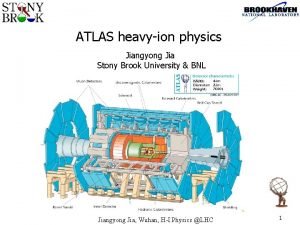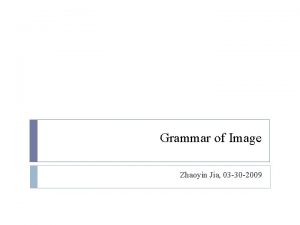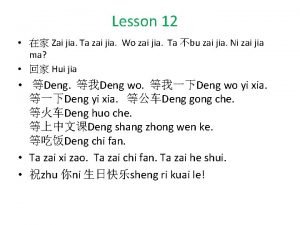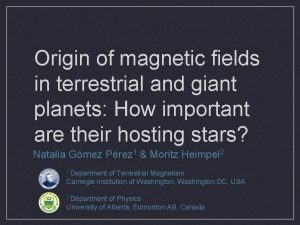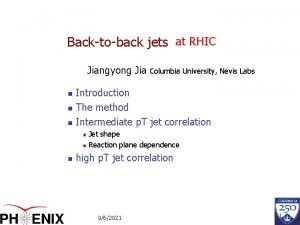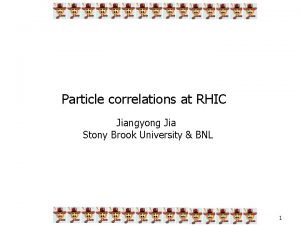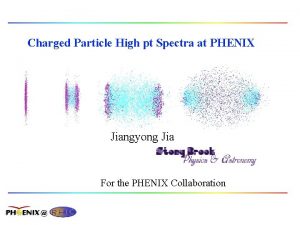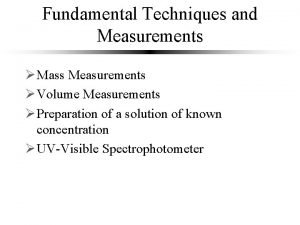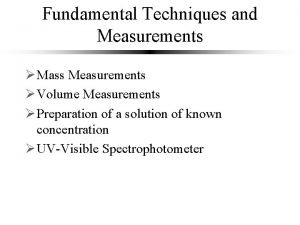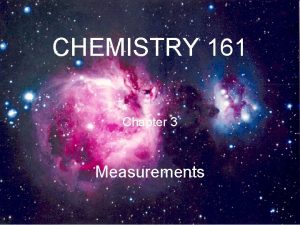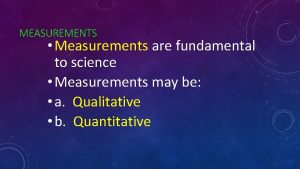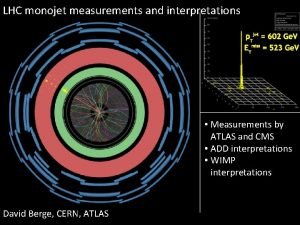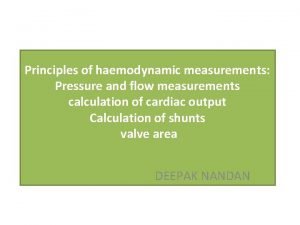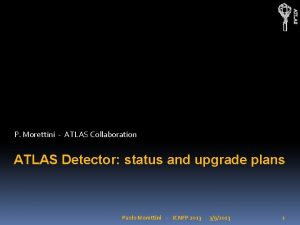ATLAS flow measurements Jiangyong Jia for the ATLAS






































- Slides: 38

ATLAS flow measurements Jiangyong Jia for the ATLAS Collaboration HPT 2012 Oct 21 th- Oct 24 th

2 Initial geometry to azimuthal anisotropy Realistic Simplified Φ 4 Φ Φ 2 Φ 3

Initial geometry to azimuthal anisotropy pressure by MADAI. us Single particle distribution Pair distribution 3

Fluctuation event by event n n Significant fluctuations, factor of ~ 2 in central events Can not be explained by detector effects (red histogram) 4

Fluctuation event by event Rich event-by-event patterns for vn and Φn! 5

Flow observables n n n Mean values of vn(p. T, η, cent). Phys. Rev. C. 86. 014907 Event by event vn distributions. ATLAS-CONF-2012 -114 Correlations between flow phases Φn. ATLAS-CONF-2012 -49 Probes into dynamical expansion of the matter Sensitive to the initial density distribution/fluctuations Extraction of the matter properties in more details 6

7 ATLAS detector EM Calorimeters -4. 9<η<4. 9 Inner detector |η|<2. 5 Forward Calorimeter (FCal) 3. 2<|η|<4. 9 n n n Tracking |η|<2. 5 for vn measurement ET in forward calorimeter 3. 2<|η|<4. 9 event plane Event plane correlations use entire calorimeter -4. 9<η<4. 9

Averaged flow: vn(cent, p. T, η) Phys. Rev. C 86, 014907 (2012) n Features of Fourier coefficients n n n vn coefficients rise and fall with centrality. vn coefficients rise and fall with p. T. vn coefficients are ~boost invariant. Flow correlations are long range! 8

vn extraction via two-particle correlations (2 PC) Phys. Rev. C 86, 014907 (2012) 2 -3 Ge. V |Δη|>2 n Long range structures (“ridge”) described by harmonics v 1, 1 -v 6, 6 ? 9

Factorization of vn, n to vn as a function of Δη n n Factorization works well for n=2 -6, weak Δη dependence Break down of v 1, 1 is due to global momentum conservation 10

11 Dipolar flow v 1 Directed (odd component) flow vanishes at η=0 Dipolar (even component) flow ~boost invariant in η Φ 1 But also include non-flow effects: Momentum of individual particle must be balanced by others: =

a, Behaviors of v 1, 1(p. T Well described by ? b) 12

Extracting the η-even v 1 (p. T) 13 Excellent Fit! Red Points: v 1, 1 data Black line : Fit to functional form Blue line: momentum conservation component

14 Extracted dipolar flow Phys. Rev. C 86, 014907 (2012) n n Negative for p. T<1. 0 Ge. V expected from hydro calculations Similar magnitudes as v 3 but much larger at high p. T n Large high p. T v 1 expected from L-dependence of energy loss 1203. 3265

Importance of dipolar flow for 2 PC (0 -5%) v 1, 1 component shown by brown dashed lines Most of v 1, 1 is due to momentum conservation Most of v 1, 1 is due to dipolar flow ~1. 5 : 1 ~3: 1 15

Flow observables n n n Mean values of vn(p. T, η, cent). Phys. Rev. C. 86. 014907 Event by event vn distributions. ATLAS-CONF-2012 -114 Correlations between flow phases Φn. ATLAS-CONF-2012 -49 16

Flow vector and smearing ? The key of unfolding is response function: 17

Split the event into two Sub-event “A” – Sub-event “C” = Signal: cancelled Fluctuations: √ 2 larger 18

Obtaining the response function 19 2 D response function is a 2 D Gaussian 1 D response function obtained by integrating out azimuth angle Data driven method

Unfolding performance: v 2, 20 -25% n Use the standard Bayesian unfolding technique n Converges within a few % for Niter=8, small improvements for larger Niter. n Many cross checks show good consistency n n n Unfolding with different initial distributions Details in ATLAS-CONF-2012 -114 Unfolding using tracks in a smaller detector Unfolding directly on the Eb. E two-particle correlation. 20

21 Flow probability distributions v 2 n n v 3 v 4 vn distributions corrected for detector effect and finite multiplicity v 2 in central, and v 3 v 4 in all centrality are described by a radial Gaussian function: driven by Gaussian fluctuation

22 p. T-scaling of the probability distribution v 2 v 3 All p. T bins have similar shape, hold for all n. Hydrodynamic response ~ independent of p. T. v 4

Measuring the hydrodynamic response Glauber and CGC mckln Rescale εn distribution to the mean of data 0 -1% 30 -35% 5 -10% 40 -45% 20 -25% 55 -60% 23 Both models fail describing p(v 2) across the full centrality range 23

Relative fluctuations: width/mean for v 2 Glauber MC-KLN n Gaussian limit Direct precision measurement of the relative fluctuations n Consistent with but more precise than those obtained indirectly from cummulant method 24

25 What does event plane vn measure? n Expectations: Verified!! ATLAS EP vn ≈ within few % vn. EP/<vn> v 2 v 3 v 4

Flow observables n n n Mean values of vn(p. T, η, cent). Phys. Rev. C. 86. 014907 Event by event vn distributions. ATLAS-CONF-2012 -114 Correlations between flow phases Φn. ATLAS-CONF-2012 -49 26

Correlation between phases of harmonic flow n n n Correlation can exist in the initial geometry and also generated during hydro evolution The correlation can be quantify via a ar. Xiv: 1205. 3585 set of simple correlators ar. Xiv: 1203. 5095 Measured quantify need to be corrected by resolution Glauber n This can be generalized into multiplane correlations 27

A list of measured correlators n List of two-plane correlators n List of three-plane correlators “ 2 -3 -5” “ 2 -4 -6” “ 2 -3 -4” Reflects correlation of two Φn relative to the third 28

Two-plane correlations Teany & Yan Rich centrality dependence patterns 29

Three-plane correlations “ 2 -3 -5” correlation “ 2 -4 -6” correlation Rich centrality dependence patterns 30 “ 2 -3 -4” correlation

Compare with Eb. E hydro calculation: 2 -plane Initial geometry + hydrodynamic Zhe & Heinz geometry only Eb. E hydro qualitatively reproduce features in the data 31

Compare with Eb. E hydro calculation: 3 -plane Initial geometry + hydrodynamic Zhe & Heinz geometry only Npart Eb. E hydro qualitatively reproduce features in the data 32

Summary n Detailed differential measurement of vn(p. T, η, centrality) for n=1 -6 n n Factorization of vn, n to vn works well for n=2 -6, but breaks for n=1 dipolar flow v 1 extracted from v 1, 1 via a two component fit. n n v 1 magnitude comparable to v 3, indicating significant dipole deformation in the initial state. High p. T v 1 may reflect L dependence of energy loss Event-by-event probability distribution of v 2 -v 4 n n n 33 Consistent with Gaussian fluctuation for v 2 in central and v 3, v 4 in all centralities The shape has no p. T dependence hydro response independent of p. T Glauber &MC-KLN model fails to describe the shape for all centralies. Event plane vn ~ RMS vn for n=3 -4, but is in between RMS and mean for n=2 Many correlations between two and three event planes n n Some correlations qualitatively similar to Glauber model, many are not Provides new constraints for initial geometry as well as hydro models Qiu and Heinz, ar. Xiv: 1208. 1200 Teaney and Yan, ar. Xiv: 1206. 1905

Dependence on prior: v 4 20 -25% n n Despite different initial distribution, all converged for Niter=64 Wide prior converges from above, narrow prior converges from below! Provide constrains on the residual non-convergence 34

Compare to unfolding for half-ID: 20 -25% n Agrees within a few % in most cases, but can be larger in the tails, which mainly reflects the non-convergence of half-ID (since width of its response function is √ 2 wider) Residual non-convergence of half-ID 35

Compare single & 2 PC unfolding with η gaps 36

How about v 3? n n Good agreement except in peripheral collisions, but this could be trivial, since all Gaussian functions have same reduced shape. Similar observation for v 4 Non-linear responses 37

v 4 comparison with eccentricity Non-linear responses 38
 Jiangyong jia
Jiangyong jia Jiangyong jia
Jiangyong jia Jiangyong jia
Jiangyong jia Jiabin chords
Jiabin chords Zhaoyin jia
Zhaoyin jia Ni jia you ji ge ren
Ni jia you ji ge ren Ai jia
Ai jia 8hui jia.com
8hui jia.com Jia-bin huang
Jia-bin huang Ta jia zai nar meaning in english
Ta jia zai nar meaning in english Ta zai
Ta zai Pengurusan kemudahan sukan
Pengurusan kemudahan sukan Ai mei jia ren
Ai mei jia ren English boon lay garden primary school
English boon lay garden primary school Translate photo
Translate photo Jia et al
Jia et al Zhihao jia
Zhihao jia Toh jia hui
Toh jia hui Oligoartiküler jia
Oligoartiküler jia Nǐ jiā yǒu jí kǒu rén?
Nǐ jiā yǒu jí kǒu rén? Ye qiu
Ye qiu Atmosfr
Atmosfr Relativ standardavvikelse formel
Relativ standardavvikelse formel Rutin för avvikelsehantering
Rutin för avvikelsehantering Vad är vanlig celldelning
Vad är vanlig celldelning Myndigheten för delaktighet
Myndigheten för delaktighet Presentera för publik crossboss
Presentera för publik crossboss Kung som dog 1611
Kung som dog 1611 Hur skriver man en debattartikel
Hur skriver man en debattartikel Tobinskatten för och nackdelar
Tobinskatten för och nackdelar Nationell inriktning för artificiell intelligens
Nationell inriktning för artificiell intelligens Referat mall
Referat mall Fimbrietratt
Fimbrietratt Verifikationsplan
Verifikationsplan Karttecken
Karttecken Rbk fuktmätning
Rbk fuktmätning Vätsketryck formel
Vätsketryck formel Förklara densitet för barn
Förklara densitet för barn Elektronik för barn
Elektronik för barn
